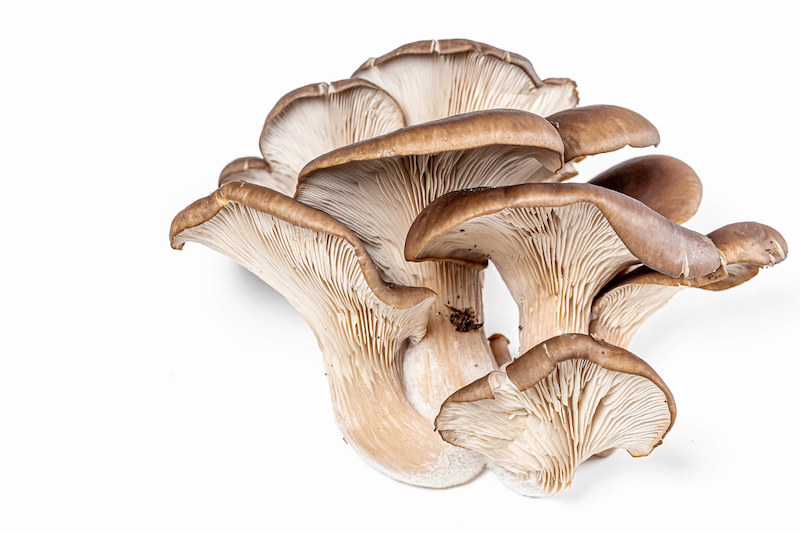The Nutritional and Medicinal Bonanza of Oyster Mushrooms: A Self-Reliant, Bursting-At-The-Seams Gold Mine of Health Benefits!
Oyster mushrooms, a fascinating genus of mushrooms that come in many colors, are a self-reliant health gold mine. They are incredibly easy to grow and are the third most cultivated mushroom globally, according to Hobbs. Oyster mushrooms can grow in a range of substrates, from supplemented sawdust to straw to toilet paper rolls and coffee grounds, making them an easy choice for beginners.
However, the concept of “easy to grow” is a relative term. Mushrooms are not philodendrons and require specialized spaces and techniques, along with a bit of extra effort. But what’s in it for the grower? What are the benefits of growing oysters and other mushroom varieties? Let’s dive deeper into the nutritional and medicinal benefits of oyster mushrooms.

Oyster mushrooms are a powerhouse of nutrients, according to Hobbs and other sources. Some species of oyster mushrooms contain up to 35% protein, are highly digestible and rich in fiber and minerals, with 15-20% beta-glucans. Stamets notes that oyster mushrooms contain high amounts of vitamins B, C, and niacin. Healthline gives a nutritional breakdown for 1 cup (85 grams) of fresh oyster mushroom, which includes calories, carbs, protein, fat, fiber, niacin, pantothenic acid, folate, choline, potassium, iron, phosphorus, and zinc. Inflationary times have made mushrooms a valuable meat substitute, too!
But the benefits don’t stop there! Oyster mushrooms have a host of medicinal benefits as well. Healthline, along with Stamets and Hobbs, discusses various studies that suggest a role for oyster mushrooms in blood sugar regulation. Hobbs notes the presence of natural statins, most notably a molecule closely related to lovastatin, in these mushrooms. He also notes possible benefits in cholesterol lowering and atopic dermatitis, along with mild immunomodulating effects. Some preliminary studies have even shown a possible anti-tumor effect, along with anti-inflammatory properties and positive effects on gut health.
MedicineNet points out several of these benefits and more, including heart health benefits and the inhibition of free radicals. Both this article and Hobbs point to studies showing that the blood regulation properties of this mushroom can help prevent type 2 diabetes. In a small study of volunteers with type 2 diabetes who ate 3-4 grams of freeze-dried and powdered oyster mushroom followed by 75 grams of glucose in 300 mL of water for two weeks, Hobbs found that blood sugar levels declined by 15-16.5% compared to controls, while insulin levels increased by 21-22%. However, Hobbs himself notes that human studies are few and far between enough to warrant some caution.

Interestingly, Hobbs notes immunomodulating, anti-inflammatory, and antiallergic effects in children with recurrent respiratory viruses. These benefits are especially noteworthy in today’s global society struggling with viruses such as SARS-Cov-2 and RSV.
If you’re a farmer or homesteader, the used substrate generated from oyster mushroom cultivation also produces several useful by-products. According to Stamets, spent straw can be fed to chickens, pigs, and cattle, while mycelial substrate is excellent for building compost and new soil! This is especially good to know when you have to toss a moldy sawdust block. At least something good will come from your efforts, if not what you were trying to grow!
Moreover, straw, sawdust blocks, and coffee grounds can be tossed into the compost bin or added to trenches and lasagna gardening layers. Stamets notes that at least five oyster species secrete metabolites toxic to nematodes. Additionally, the spent straw can be used to grow wine caps outdoors. Wine caps, besides being delicious, are also used in mycoremediation, a fancy word for cleaning pollutants out of soils via fungi. However, it is crucial to note that any mushroom used for this purpose should not be eaten, as the pollutant(s) will be stored within the mushroom.
While oyster mushrooms are incredibly beneficial, there are also some disadvantages and side effects of consuming them. The mushrooms are quick to spoil, so once you pick them, either dehydrate or use them, as they won’t last more than a couple of days in the refrigerator.
Stamets notes that oyster mushrooms attract flies to the grow room like no other species, which can contaminate the entire growing area. These mushrooms drop spores to the point that it can be a health hazard, which is one good reason to keep a good filter over your duct fan’s outflow in your Martha tent.
Moreover, according to MedicineNet, oyster mushrooms may cause allergies and are not suitable for sensitive stomachs. Hobbs notes that there are a few toxic look-alikes, so be very careful if you go foraging! It is recommended to use a good field guide or take a class from someone local who can help you. Poisoning yourself by eating the wrong mushroom is not fun, as a local woman has experienced twice. Some of those look-alikes are lethal, so be cautious!

In conclusion, oyster mushrooms are an incredible genus of mushrooms that are easy to grow and come with a wide range of nutritional and medicinal benefits. The used substrate generated from oyster mushroom cultivation also produces several useful by-products for farmers and homesteaders. However, it is essential to note the disadvantages and side effects of consuming these mushrooms, such as quick spoilage, fly attraction, allergies, and toxic look-alikes. As always, it is recommended to seek professional advice before consuming any new food for health reasons.



